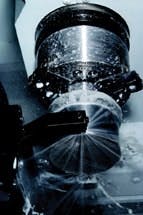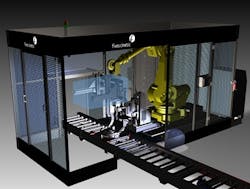To make its pulleys, Pfeifer formerly turned them on a CNC lathe, drilled bolt holes on a vertical machining center and hobbed the pulleys' teeth on a gear hobber. To simplify this procedure, Pfeifer implemented Mori Seiki's NL 2000 SMC gantry-loaded CNC lathe just two years ago. NL 2000 includes a multi-spindle, live tool and one standard axis, which eliminates the need for the machining center.
And the good news didn't end there. Pfeifer added Mori Seiki's first HydroGage automated gauging system to its NL 2000 just over a year ago. HydroGage works like an air gauge, but it replaces air with high-pressure, high-volume coolant (Figure 1) and then precisely checks the fluid's back pressure to inspect Pfeifer's bore accuracy to within 0.0004 in. Another advantage is that Hydrogage's 1,000 lb of outward pressure never allow it to get dirty like other instruments. "We can even set up a low and high tolerance band, such as 0.0006–0.0002 in., and let our NL 2000 inspect its own parts, auto correct itself and run unattended overnight," explains Donovan. "We no longer need a guy to stand in front of the machine and measure every part as it comes out. As a result, Mori Seiki saved us a lot of time and gave us a lot of confidence and peace of mind."
Figure 1: Pfeifer Industries uses Mori Seiki's high-pressure, high-volume HydroGage coolant-based gauge to automatically measure and inspects parts made by Mori Seiki's NL 2000 SMC gantry-loaded CNC lathe for Pfeifer's metric timing belt pulleys.
MORI SEIKI
Zero In
Accurately identifying and meeting the needs of industrial-machine users was never easy, and it's speeding up and getting a lot more complicated lately. Many machine builders that used to simply design, build, sell and provide basic support for their devices find themselves in ever-closer, accelerated and often pricklier relationships with customers, and these longer-term arrangements, often based on total cost of ownership (TCO), can span much of the lifetime of their machines.
Of course, competition and economics always drive manufacturers and their machine builders to improve quality, offer more varied capabilities and do more and more with less and less. However, the recent global recession and continuing lack of credit for operating capital amplifies these forces and puts even more pressure on users and builders, especially those in automotive and related industries.
"Users in some industries have cut their short-term technology purchases, but many still need to produce new products that they can't make on existing equipment," explains Hyatt, who is Mori Seiki's engineering vice president. "In addition, energy and raw material costs are only going to rise, so aerospace manufacturers, for example, need to build more fuel-efficient engines. However, they can't handle many of these new materials, alloys, geometries and tolerances with their existing tools, so they're going to need new machines."
This is why experienced machine builders seek, implement and adjust strategies to meet users' needs and develop new and better tools, as well.
Builder Form Follows User Function
Many long-time builders report it's the continually changing and diversifying needs of their users that pulled them into machine building in the first place and now drives their evolution. For example, Buckeye Machine Fabricators in Forest, Ohio, started as a metal and machining shop but began to design and build its own machines about 30 years ago in response to demands from its customers in the plastics, home appliance and lighting industries, says Troy Richey, Buckeye's vice president of technical development. "We started with small, stand-alone machines for drilling cutting and assembling parts and then slowly connected them into bigger and bigger assembly and material-handling lines. We simply gelled from making parts to making complete systems."
Likewise, Ehrhardt Tool and Machine in Granite City, Ill., says it diversified over the past 15 years to give its HVAC unit manufacturers and automated appliance users the one-stop shopping they demand. As a result, where Ehrhardt traditionally made metal-stamping dies and precision stampings, it now offers customized automated machines to help its customers assemble multiple parts into new HVAC models with far fewer operators. "Similar to most others, our customers want to reduce labor costs, have operators do more value-added work, increase production and improve quality, and so we've been adding more automation over the past 10 years," says Andy Adams, Ehrhardt's sales director. "For example, the wrapper on our furnace used to be punched and notched and the flange was bent manually. Now we have an automatic, coil-fed production line that can automatically change over to six or seven different parts, which requires a lot fewer operators."
Adams reports that Ehrhardt's HVAC assembly systems use EtherNet/IP networking for remote troubleshooting and can access its machines at a user's facility via its server and virtual private network (VPN). "If a user's machine has issues, we can log in and view the steps that a particular machine is performing. In fact, we've been in one customer's system about a dozen times this past year," adds Adams. "This also is useful because some customers don't have as many highly trained technicians as they used to, so we can be more helpful when they have problems."
|
Understand the Needs
Though most users know they want to improve or speed up their process, Richey says they often rely on their builders to turn ideas into reality. "They don't say how to do it, so we have to invent it," says Richey. "We mostly do case-by-case, one-of-a-kind projects that are designed and built to specific needs. People come to us when they can't buy a machine off the shelf. It still can be little scary for us sometimes, but many projects are similar to ones we've done before. It also takes lot of creativity to experiment and prototype, but this helps us get comfortable with what we can do. For instance, we'd rather do a slower-moving wrapping or assembly machine than a high-speed packaging machine."
Though requests from users have always ranged from simple to complex, Richey adds that Buckeye sees more demand lately for data-collection functions tied to quality-control systems, as well as more requests for parts-tracking capabilities.
Richey adds that sometimes Buckeye has to refuse to tackle projects because there are too many unknowns and risks. "We don't say that very often," he explains. "But one end user came to us recently and asked us to quote repairing an audio-speaker assembly machine they'd bought in another country. We took a look at it and decided there was no way to put a price tag on it. We weren't even sure if it was possible to make the system work. The original machine builder had actually given up on that machine, so we were reluctant to jump into a potential pitfall. Sometimes, smaller, less-experienced machine builders quote jobs they probably shouldn't do, and so many of them aren't around very long."
Collaborate and Plan Early
Once a machine builder knows what the machine user really wants and needs, an even closer working relationship needs to be established. This is essential, so the two partners can jointly solve issues and plan a machine that will be useful and efficient.
"The biggest struggle these days is that there's not enough upfront planning between builders and customers on projects," says Adams. "I can't think of a project in which our customers haven't changed parts multiple times throughout the build. The projects are getting more and more complex, and so the solution is to get involved much earlier in the design and even concept process, so we don't have customers drawing up 3D parts that can't be made or are far too costly."
Ehrhardt's engineers sit down with a customer's product designer, guide them during the design process and come up with the least costly solution that's practical to manufacture. "If an HVAC manufacturer asks us to build a machine, we try to have the specifications from a past machine, as well as safety and ergonomic data, already on hand, so we can use it as a foundation for the newer capabilities and machine devices."
Rearranged Lines and Common Components
Besides merely revamping designs and machines, some builders reconstruct whole work cells and production lines to better meet user requirements. For instance, to help engine block and transmission manufacturers operate faster and less expensively, Cinetic Automation in Farmington Hills, Mich., recently developed its TruFlex work cell, which employs robots rather than the usual pneumatic slides and gantries for machine movement. Though it can use other major robot brands, TruFlex presently consists of a Fanuc robot guided by a Fanuc vision system and controlled by Siemens Industry's Simatic software and networked via Profibus-DP (Figure 2). The robot can accommodate up to 16 axes, but TruFlex usually employs six or seven.
Figure 2: Cinetic Automation is installing 37 of its robot-based TrueFlex workcells at the General Motors plant in Flint, Mich., which is scheduled to begin making Chevrolet Volt electric cars soon.
CINETIC AUTOMATION
Stencel adds that TruFlex is based on a standardized station onto which the robot is installed, while the robot can be equipped with one or several standard, end-of-arm "toolboxes." These include fastening spindles, liquid gasket applicators, pressing systems and material handling and loading tools. "These flexible components let us reduce TruFlex's delivery time by 20% — from 44 to 36 weeks — for a full system. This makes us competitive and makes our customers happy."
Become the User—and Vice Versa
Hyatt says Mori Seiki's engineers typically spend so much time on their customers' factory floors and are so familiar with many of these users' own customers and suppliers that Mori Seiki can begin to see some users' needs before they become aware of them. They also hire people who've worked in their users' industries and similar applications. "You have to not just listen, but also listen carefully enough to read between the lines to hear the unarticulated needs," explained Hyatt. "This is hard to do, but I think we're able to find even more beneficial requirements."
Conversely, Donovan says NL 2000 is supposed to be a high-volume machine, but Pfeifer turned the tables on Mori Seiki a bit and decided to use it like a low-volume, almost manual machine. "We use this machine during the day to run our low-volume and custom parts. However, at night, we can use it to run any of our volume-production jobs," says Donovan. "We didn't think we needed a lot of bells-and-whistles automation, but NL 2000 lets us satisfy the needs of both our low- and high-volume customers."
[sidebar id="3"]
Adams agrees that a true partnership philosophy means the machine builder must think as the user does. "If a builder can help with a process change that increases productivity and quality, then the builder can save the customer a lot of money."
Virtual Design and Testing
To help embrace the customer mindset, another tool that some machine builders employ is computer-aided design (CAD) software and, more recently, 3D CAD. As these programs grow more sophisticated, the resulting designs ever more closely reflect the machines to be built and the way they'll operate. There's often enough data for builders to virtually test and simulate the machines long before they're constructed. That means less need for physical prototypes, easier configuration, quicker turnaround and faster delivery.
Richey says Buckeye recently worked on a six-axis robotic and vision system for unloading pallets of windshield glass. Because the company hadn't built this type of unloading system before, it used Autodesk's Inventor 3D CAD software to design and virtually assemble its components. "We had to manage pallets on a turntable, get them in the right location for a Motoman robot and include end-of-arm tooling to pick up the glass every few seconds," explains Richey. "The robot and vision system then reads barcodes on the glass and sends it to the right conveyor where each line adds clips or weather-stripping before final inspection. Our 3D CAD tools helped get this project up and running in the limited time we had. We're currently working on a similar proposal to put auto glass back on a pallet."
Once you're fully prepared, successfully fulfilling users' requirements might seem like no more than simple execution. However, experienced machine builders add there are many ways to meet users' needs while a project is underway. Here are some of the best ways to meet users' needs during a machine building project.
- Communicate constantly. Talk back and forth internally between machine builder departments and externally between the builder and end user's organizations to find and add any needed modifications as soon as possible.
- Document all projects and processes. Adopt a formal documentation process for every stage of a project as it moves though your organization so all departments can communicate better and no tasks or problems are left undone.
- Expect to be flexible. Whatever the industry or application, there will almost always be changes that users want to make as their machines are being built.
- Follow up. All of the initial discussions and exchanges before and during a project and the documentation that follows must culminate in a thorough policy for following up on outstanding tasks and issues. And this policy needs to continue after the machine is installed as part of its maintenance and overall total-cost-of-ownership (TCO) and/or lifecycle evaluation program.
Streamline With Standards
Besides developing new tools and better collaboration with users, many builders are adopting standards-based methods for their devices and processes to make them more consistent and efficient. To take on new and sometimes untried projects, Richey adds that Buckeye's engineers must sometimes take risks, but they try to be smart when they do. "You have to stretch your neck out without getting it chopped off," he says. "This means calculating risks, so when one department says let's take on a project, the others have to consider if we're biting off more than we can chew. Our departments work hand-in-hand, so we can all get in trouble at the same time. But seriously, we talk early and at all stages of a project, and we've developed a formal, in-house quality control system based on ISO 9000 standards, which address how our departments work and communicate, establishes checks and balances for documenting all our designs and project quotes and describes how jobs should flow through our manufacturing facility. This documentation is crucial because, while being lean boils down to dollars, staying competitive comes down to how innovative you are and having better ideas. It isn't always the price that sells a project; it's also the builder's ability to convince a customer that you know what you're doing. Good people, tools and facilities can turn machines around more quickly and at less cost without sacrificing quality."
About the Author
Jim Montague
Executive Editor, Control
Jim Montague is executive editor of Control. He can be contacted at [email protected].

Leaders relevant to this article:





